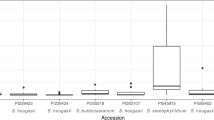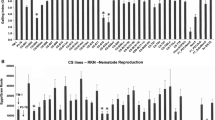Abstract
Columbia root-knot nematode (Meloidogyne chitwoodi) (CRN) is a serious pest of potato in the Pacific Northwest of the USA. Because this nematode can reproduce rapidly within a single growing season, small initial populations are capable of causing crop loss in the Columbia Basin of Washington or Oregon. Presently, soil fumigation is the main treatment for controlling CRN on potato. Developing potato varieties with resistance to CRN is highly desirable to reduce the cost of control and to alleviate concerns about the effects of fumigants on the environment. Resistance to CRN race 1 was found in two wildSolanum species. Resistance fromS. bulbocastanum was introduced via protoplast fusion and fromS. hougasii via sexual hybridization. Subsequent breeding consisted of repeated backcrossing and selection. The dominant monogenic inheritance was expressed in undiminished fashion across several backcross generations. When tested in replicated trials in three locations, selected resistant clones from the BC4 and BC5 of theS. bulbocastanum introgression populations had total marketable yields and yields of >113-g (4 oz) tubers as good or better than standard potato varieties tested in replicated yield trials in three locations. Percentage of tubers weighing more than 113 g in the highest yielding clones was not significantly different from commercial standards. The resistance phenotype, typified by failure of the nematode to reproduce on the root systems, was sufficiently effective to prevent economic damage in a field exposure. All CRN-resistant clones are pollen sterile. Germplasm listed is available upon request.
Resumen
El nematodo del nudo de Columbia (Meloidogyne chitwoodi) (CRN), es un parásito serio de la papa en la zona del Pacífico noroeste de los EUA. Poblaciones iniciales pequeñas son capaces de ocasionar la pérdida del cultivo, debido a la habilidad de este nematodo a reproducirse rápidamente dentro de un mismo periodo de cultivo en los valles de Columbia de Washington u Oregon. Actualmente, la fumigación del suelo es el principal método de control del CRN de la papa. El desarrollo de resistencia al CRN es muy deseable para reducir los costos de control y la preocupación que se tiene de los fumigantes sobre el medio ambiente. Se encontró resistencia a la traza 1 del CRN en dos especies silvestres deSolanum spp. La resistencia deS. bulbocastanum se introdujo por fusión de protoplastos y la deS. hougasii por hibridación sexual. Las siguientes pruebas de mejoramiento consistieron en retrocruzas repetidas y selección. La herencia monogénica dominante fue expresada a lo largo de varias generaciones de retrocruza. Cuando se hicieron pruebas múltiples en tres localidades, los clones resistentes seleccionados de BC4 y BC5 de la población de introgresión deS. bulbocastanum tuvo un rendimiento total comerciable de tubérculos por encima de los 113g (4 onzas), tan bueno o mejor que las variedades estándar de papa evaluadas en pruebas de rendimiento con repeticiones en tres localidades. El porcentaje de tubérculos con pesos mayores a los 113 gramos en el clon de mayor rendimiento, no mostró diferencia significativa en comparación con los estándares comerciales. La resistencia del fenotipo, tipificado por la falta de reproducción del nematodo en los sistemas de raíces, fue suficientemente efectiva para prevenir el daño económico en la exposición de campo. Todos los clones resistentes CRN son de polen estéril. El germoplasma incluido en la lista está disponible para quien lo solicite.
Similar content being viewed by others
Literature cited
Austin S, JD Pohlman, CR Brown, H Mojtahedi, GS Santo, D Douches, and JP Helgeson. 1993. Interspecific somatic hybridization betweenSolanum tuberosum L. andS. bulbocastanum DUN. as a means of transferring nematode resistance. Am Potato J 70:485–495.
Brown CR, H Mojtahedi, and GS Santo. 1989. Comparison of reproductive efficiency ofMeloidogyne chitwoodi onSolanum bulbocastanum in soil andin vitro tests. Plant Dis 73:957–959.
Brown CR, H Mojtahedi, and GS Santo. 1991. Resistance to Columbia root-knot nematode inSolanum ssp. and in hybrids ofS. hougasii with tetraploid cultivated potato. Am Potato J 68:445–452.
Brown CR, H Mojtahedi, GS Santo, and S Austin-Phillips. 1994. Enhancing resistance to root-knot nematodes derived from wildSolanum species in potato germplasm.In: GW Zehnder, ML Powelson, RK Jansson, and KV Raman (eds), Advances in Potato Pest Biology and Management. Am. Phytopathology Society, Minneapolis, MN. pp 426–438.
Brown CR, H Mojtahedi, and GS Santo. 1995. Introgression of resistance to Columbia and Northern root-knot nematodes fromSolanum bulbocastanum into cultivated potato. Euphytica 83:71–78.
Brown CR, H Mojtahedi, and GS Santo. 1999. Genetic analysis of resistance toMeloidogyne chitwoodi introgressed fromSolanum hougasii in cultivated potato. J Nematology 31:264–271.
Brown CR, H Mojtahedi, and GS Santo. 2003. Characteristics of resistance to Columbia root-knot nematode resistance introgressed from several Mexican and American wild potato species. Acta Hort 619:117–125.
Brown CR, C-P Yang, H Mojtahedi GS Santo, and R Masuelli. 1996. RFLP analysis of resistance to Columbia root-knot nematode derived fromSolanum bulbocastanum in a BC2 population. Theor Appl Gen 92:572–576.
Debener T, F Salamini, and C Gebhardt. 1990. Phylogeny of wild and cultivated Solanum species based on nuclear restriction fragment length polymorphisms (RFLPs). Theor Appl Genet 79:360–368.
Hussey RS, and KR Barker. 1973. A comparison of methods of collecting inocula ofMeloidogyne spp. including a new technique. Plant Dis Rep 57:1025–1028.
Janssen GJW, OE Scholten, A van Norel, and CJ Hoogendoorn. 1998. Selection of virulence inMeloidogyne chitwoodi to resistance in the wild potatoSolanum fendleri. Eur J of Plant Pathol 104:645–651.
Janssen GJW, A van Norel, R Janssen, and J Hoogendoorn. 1997. Dominant and additive resistance to the root-knot nematodesMeloidogyne chitwoodi andM. fallax in Central AmericanSolanum species. Theor Appl Genet 94:692–700
Janssen GJW, A van Norel, B Verkerk-Bakker, and R Janssen. 1996. Resistance toMeloidogyne chitwoodi, M. fallax, andM. hapla in wild tuber-bearingSolanum spp. Euphytica 92:287–294.
Mojtahedi H, CR Brown, and GS Santo. 1995. Characterization of resistance in a somatic hybrid ofSolanum bulbocastanum andS. tuberosum toMeloidogyne chitwoodi. J Nematology 27:86–93.
Mojtahedi H., GS Santo, CR Brown, H. Ferris, and V. Williamson. 1994. A new host race ofMeloidogyne chitwoodi from California. Plant Dis 78:1010.
Mojtahedi H, GS Santo, and JH Wilson. 1988. Host tests to differentiateMeloidogyne chitwoodi races 1 and 2 andM. hapla. J Nematology 20:468–473.
Mojtahedi H, GS Santo, JH Wilson, and AN Hang. 1993. ManagingM. chitwoodi on potato with rapeseed as green manure. Plant Dis 77:42–46.
Oostenbrink M. 1966. Major characteristics of the relation between nematodes and plants. Mded Lanbouwhogeschool, Wageningen 66:3–46.
Pinkerton JN, GS Santo, and H Mojtahedi. 1991. Population dynamics of ofMeloidogyne chitwoodi on Russet Burbank potato in relation to degree day accumulation. J Nematology 23:283–290.
Santo G S, JH O’Bannon, AP Nycezpir, and RP Ponti. 1981. Ecology and control of root-knot nematodes on potato. Proceedings of the 20th Annual Washington State Potato Commission, Moses Lake, WA. pp 135–139.
Santo GS, and JN Pinkerton. 1985. A second race ofMeloidogyne chitwoodi discovered in Washington State. Plant Dis 69:361.
Sasser JN, CC Carter, and KM Hartman. 1984. Standardization of host suitability studies and reporting of resistance to root-knot nematodes. North Carolina State University Graphics, Raleigh, NC.
Steel RGD, and JH Torrie. 1980. Principles and procedures of statistics: A biometrical approach. McGraw-Hill, New York.
Author information
Authors and Affiliations
Corresponding author
Rights and permissions
About this article
Cite this article
Brown, C.R., Mojtahedi, H., James, S. et al. Development and evaluation of potato breeding lines with introgressed resistance to Columbia root-knot nematode (Meloidogyne chitwoodi). Am. J. Pot Res 83, 1–8 (2006). https://doi.org/10.1007/BF02869604
Accepted:
Issue Date:
DOI: https://doi.org/10.1007/BF02869604




